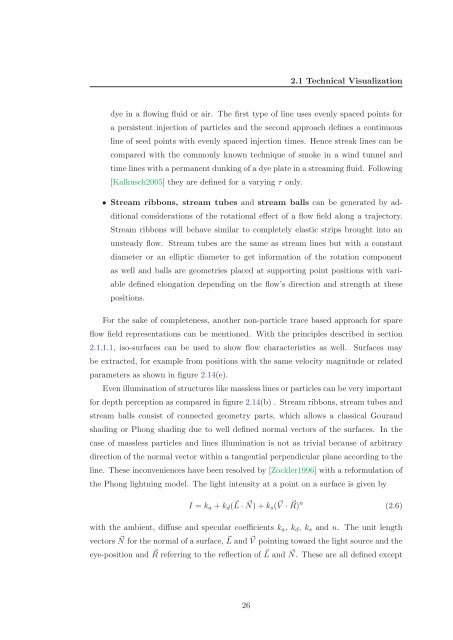Master's Thesis - Studierstube Augmented Reality Project - Graz ...
Master's Thesis - Studierstube Augmented Reality Project - Graz ...
Master's Thesis - Studierstube Augmented Reality Project - Graz ...
Create successful ePaper yourself
Turn your PDF publications into a flip-book with our unique Google optimized e-Paper software.
2.1 Technical Visualization<br />
dye in a flowing fluid or air. The first type of line uses evenly spaced points for<br />
a persistent injection of particles and the second approach defines a continuous<br />
line of seed points with evenly spaced injection times. Hence streak lines can be<br />
compared with the commonly known technique of smoke in a wind tunnel and<br />
time lines with a permanent dunking of a dye plate in a streaming fluid. Following<br />
[Kalkusch2005] they are defined for a varying τ only.<br />
• Stream ribbons, stream tubes and stream balls can be generated by additional<br />
considerations of the rotational effect of a flow field along a trajectory.<br />
Stream ribbons will behave similar to completely elastic strips brought into an<br />
unsteady flow. Stream tubes are the same as stream lines but with a constant<br />
diameter or an elliptic diameter to get information of the rotation component<br />
as well and balls are geometries placed at supporting point positions with variable<br />
defined elongation depending on the flow’s direction and strength at these<br />
positions.<br />
For the sake of completeness, another non-particle trace based approach for spare<br />
flow field representations can be mentioned. With the principles described in section<br />
2.1.1.1, iso-surfaces can be used to show flow characteristics as well. Surfaces may<br />
be extracted, for example from positions with the same velocity magnitude or related<br />
parameters as shown in figure 2.14(e).<br />
Even illumination of structures like massless lines or particles can be very important<br />
for depth perception as compared in figure 2.14(b) . Stream ribbons, stream tubes and<br />
stream balls consist of connected geometry parts, which allows a classical Gouraud<br />
shading or Phong shading due to well defined normal vectors of the surfaces. In the<br />
case of massless particles and lines illumination is not as trivial because of arbitrary<br />
direction of the normal vector within a tangential perpendicular plane according to the<br />
line. These inconveniences have been resolved by [Zockler1996] with a reformulation of<br />
the Phong lightning model. The light intensity at a point on a surface is given by<br />
I = k a + k d ( L ⃗ · ⃗N) + k s ( V ⃗ · ⃗R) n (2.6)<br />
with the ambient, diffuse and specular coefficients k a , k d , k s and n. The unit length<br />
vectors N ⃗ for the normal of a surface, L ⃗ and V ⃗ pointing toward the light source and the<br />
eye-position and R ⃗ referring to the reflection of L ⃗ and N. ⃗ These are all defined except<br />
26





